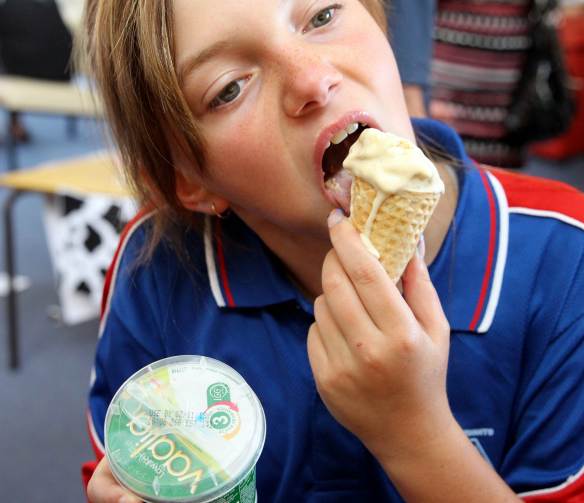Continuing on our epic judging day at the Rouse Hill Town Centre library
School Twenty Two was Model Farms High School
Is it a bird? Is it a plane? No, it’s Wool I Am. The super-cow! He has his cape (made from knitted patchwork squares) flying behind him and a knitted mask..
This is a cow in a form we have never seen before! By breaking the cow into three separate pieces, it allowed them to individually showcase different areas of the wool industry. The initial idea came from the desire to view the cow from multiple angles and to see different elements each time.
Each of the segments tells a story about a different part of the wool industry. The front segment represents ”the farm, the pastures the sheep in their fields” (as well as being filled with balls of wool which represent bales of wool ready for export).
The centre segment represents “the label from a ball of wool and includes some of the important information that encourages us to buy the product”. The interior of this segment depicts the internal organs of a cow.
The rear segment “reflects the business end of the wool industry, once the wool has left the farm”. Spirals of smoke tell us what the main woollen products are. “The embroidered end describes the processes used on a farm and life from shearing the sheep, wool types and the export of bales”.
A truly inventive cow!
School Twenty Three was Elizabeth Macarthur High School
Eye-popping colour, clean lines and a clear message are all shown by “Apple” at first glance. Her name (which links to a sheep from the schools’ farm) is the most mysterious part of her!
“Apple” shows a whole world of influences as she speaks about the Australian wool industry. She uses simplicity and a series of wrapped woollen images, overlaid on a simplified paddock backdrop with layers of earth below. This backdrop wraps all the way around the cow to give her a beautiful consistency.
Her impeccably wrapped woollen images show, on one side, the world (as we export a large portion of our wool), and on her other side an image of the iconic shearer from the early Australian painting by Tom Roberts called “Shearing the Rams”. The Woolmark and Woolblend logos also feature.
“Apple” also references the classic Holeproof TV ads where the farmer puts his sheep in bright red Holeproof socks.
The eye-popping red contrasts beautifully with the vibrant woollen and painted images. The red is picked up again in her wrapped horns and tail and in the bunch of apples which hang around her neck like a series of cowbells.
School Twenty Four was Winmalee High School
“Winmeatlee” takes the beef industry from ”farm to plate”, and tells the story of how Australian cattle feed a nation of hungry meat lovers.
With strong stylistic influences drawn from Roy Lichtenstein and Howard Arkley, “Winmeatlee” was always going to be bold and vibrant. She is definitely a modern cow appealing to a modern audience! She references mass media and youth culture.
One side of “Winmeatlee” tells the ‘farm’ story, while the other side tells a ‘suburban’ story. The base links from farm to consumer, though the stories of export, meat cuts and some of the benefits of eating beef. Her feed trough cleverly does not contain food for her, but instead contains food we eat. The meals represented were chosen as the results of a school survey of the most common beef meals.
Her consistent styling links all components of the story together beautifully and she is sure to catch the eye of anyone passing by!
School Twenty Five: Jamison High School
“Hathor” (which is one of the Egyptian names for their goddess of agriculture) takes us on a journey around the world!
This world trip passes through the main countries which Australia exports beef to, and depicts these countries through an iconic image associated with that country. Amongst these images we see the Statue of Liberty (representing the USA), the Great Wall of China (representing China), Babushka dolls (representing Russia) and camels representing the Middle East.
Secondary countries which Australia exports beef to are shown through an image of their flags. Different cattle breeds and butchers shops are also shown.
At her feet, this goddess has a well-travelled suitcase, filled with the essentials for any discerning traveller (of the bovine variety) and becomes her passport to travel the world.








































































